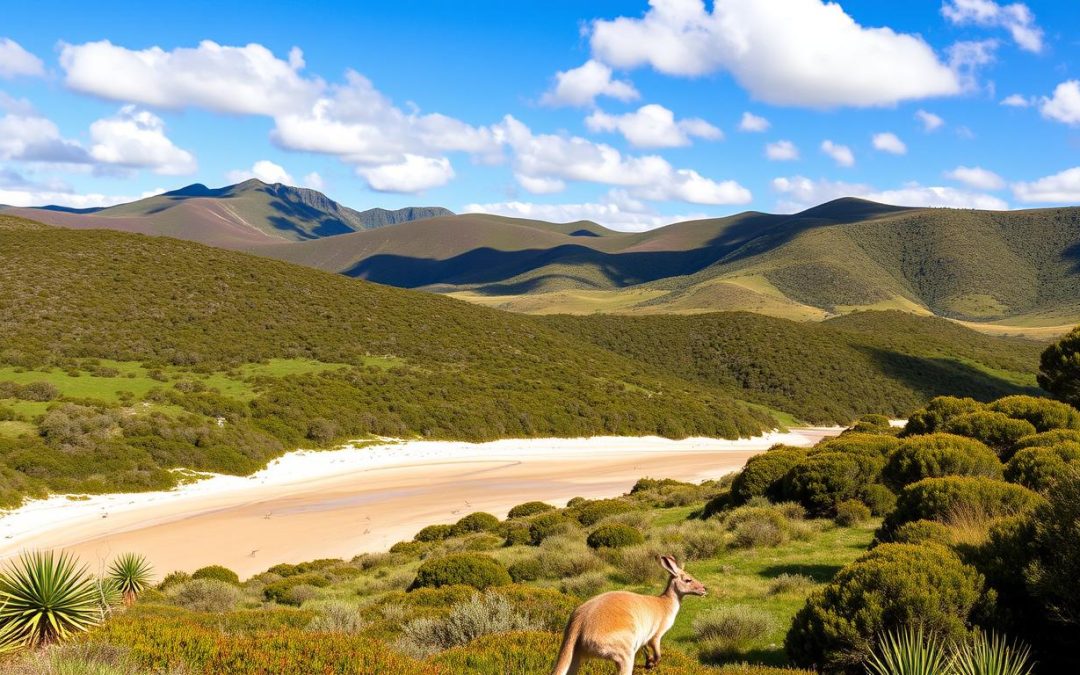Ever wondered where Tasmania’s wildlife comes alive? Narawntapu National Park offers a unique wilderness experience. It challenges what you thought you knew about Australian landscapes.
Located on Tasmania’s stunning north coast, Narawntapu National Park covers 44 km² of breathtaking terrain. It’s nestled between Greens Beach and Bakers Beach. This remarkable destination invites adventure seekers and nature lovers to explore its diverse ecosystems.
Known as the “Serengeti of Tasmania,” this national park promises unparalleled wildlife encounters. From grasslands full of marsupials to coastal landscapes stretching as far as the eye can see, Narawntapu delivers an immersive natural experience unlike any other.
Key Takeaways
- Explore 44 km² of pristine Tasmanian wilderness
- Witness incredible wildlife at dusk
- Experience diverse coastal and grassland ecosystems
- Discover multiple hiking and nature trails
- Enjoy convenient access from Devonport and Launceston
A Brief Introduction to Tasmania’s Serengeti
Narawntapu National Park is on Tasmania’s rugged north coast. It’s a stunning Tasmanian nature reserve that shows the island’s beauty. Known as “Tasmania’s Serengeti,” it’s famous for its wildlife and vast landscapes.
Location and Historical Background
The park was set up in 1976. It covers a big area that shows Tasmania’s varied ecosystems. It was once called Asbestos Range National Park, showing its importance in Tasmania’s history and culture.
Journey of a Name
In 2000, the park was renamed from Asbestos Range to Narawntapu. This name comes from the Aboriginal language. It means the coastal area between West Head and Badger Head. The name change shows respect for the area’s indigenous history.
Aboriginal Heritage and Significance
The park’s Aboriginal heritage is a big part of its story. Indigenous people have been connected to this land for thousands of years. This heritage includes:
- Traditional hunting grounds
- Spiritual significance of the coastal landscape
- Preservation of cultural practices
“The land speaks to those who listen” – Traditional Aboriginal wisdom
Visiting Narawntapu lets you see a beautiful Tasmanian nature reserve. You’ll also learn about Tasmania’s first people and their culture.
Getting to Narawntapu National Park
Exploring scenic drives in Tasmania to Narawntapu National Park is a journey you won’t forget. It’s just 42 kilometers west of Devonport. This makes it easy for those visiting Tasmania’s northern areas.
There are many routes to choose from, each showing off the island’s beauty. From Devonport, you’ll pass through lovely countryside. You’ll see Tasmania’s natural wonders in about 40 minutes. The views of hills and farms are amazing.
Travel Routes and Distances
| Starting Point | Distance | Estimated Travel Time |
|---|---|---|
| Devonport | 42 kilometers | 40 minutes |
| Launceston | 95 kilometers | 1 hour 15 minutes |
| Hobart | 290 kilometers | 3 hours 45 minutes |
Get ready for an amazing trip. Don’t forget to pack:
- Spare water and snacks
- Navigation tools
- Camera for capturing landscapes
- Comfortable clothing
“The journey is the destination when exploring Tasmania’s stunning national parks.”
Every route to Narawntapu National Park is special. It’s an adventure in itself.
Natural Landscapes and Geography
Explore the stunning Narawntapu National Park, a true marvel of Tasmania’s natural beauty. This park is a treasure trove of diverse landscapes. Each step you take reveals a new wonder of nature.
Mount Asbestos and Grasslands
Mount Asbestos, towering at 400 meters, is the park’s centerpiece. It’s surrounded by vast grasslands that stretch as far as the eye can see. These grasslands are home to many animals and offer breathtaking views along the coast.
Coastal Features and Wetlands
Narawntapu National Park is known for its incredible coastal scenery. It features:
- Dramatic headlands with sweeping ocean views
- Pristine sandy dunes
- Intricate lagoon systems
- Rich wetland ecosystems
Rivers and Inlets
The park’s rivers and inlets are vital to its ecosystem. They support a wide range of wildlife and provide water sources.
“Nature has crafted a masterpiece of geological diversity in Narawntapu National Park” – Local Naturalist
Visiting these landscapes is like stepping into Tasmania’s wild heart. Every step uncovers a new natural wonder.
Wildlife Viewing Opportunities
Narawntapu National Park is a wildlife paradise, known as Tasmania’s “Serengeti”. It’s a great place to see native Australian animals in their home. The park’s unique environment is home to many marsupials and birds, exciting for nature lovers.
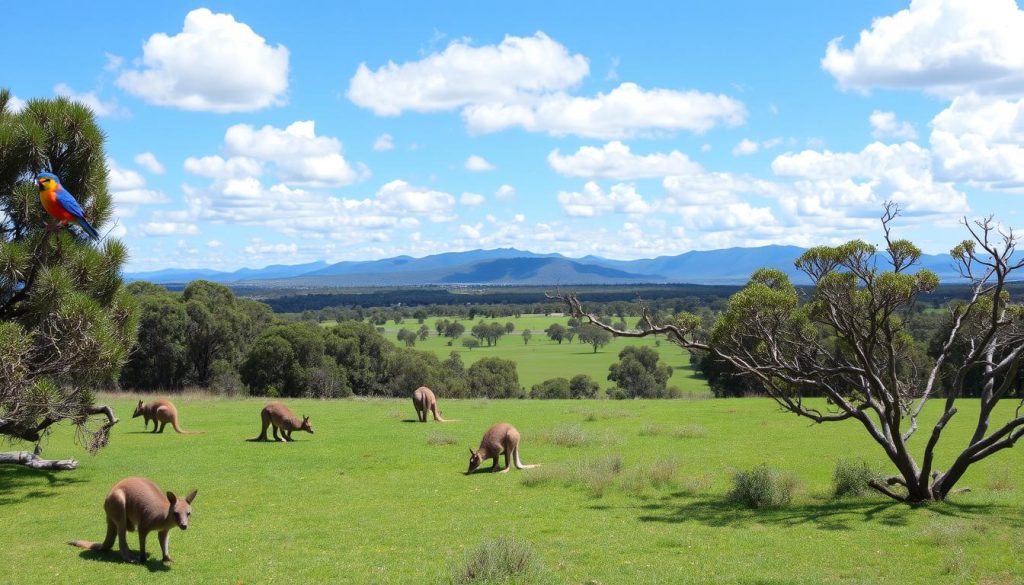
The best times to see animals are at dawn and dusk. During these hours, the park’s wildlife is most active. You can see:
- Tasmanian Devils – The world’s largest carnivorous marsupials
- Bennett’s Wallabies
- Wombats
- Pademelons
- Quolls
Tasmanian devils are endangered, with 70% lost to a facial tumour disease. Seeing them is truly special.
“Nature’s most incredible show happens right here in Narawntapu National Park” – Tasmanian Wildlife Conservation Society
Bird watchers will love spotting rare birds like the Hooded Plover and Swift Parrot. The park’s varied landscapes are crucial for these birds’ survival.
Here are some tips for a great wildlife spotting experience:
- Bring binoculars
- Move quietly
- Wear neutral-colored clothing
- Respect animal habitats
- Avoid using flash photography
Responsible wildlife viewing helps these amazing animals thrive in their natural world.
Best Walking Trails and Hiking Adventures
Narawntapu National Park has an amazing network of hiking trails. These trails show off Tasmania’s stunning coastal walks and beautiful landscapes. With 12 hiking routes, there’s something for everyone to enjoy.
The park has trails for all skill levels. Whether you’re up for a tough full-day hike or a relaxing walk, you’ll find something special. This Tasmanian wilderness is full of amazing experiences.
Coastal Traverse Trail
The Coastal Traverse Trail is a must-see for coastal walks in Tasmania. It spans 9 hours of stunning views. This challenging path goes from Bakers Beach to Greens Beach, offering a unique coastal journey.
- Total distance: Approximately 15-20 kilometers
- Difficulty: Advanced
- Recommended for experienced hikers
- Stunning ocean and grassland views
Point Vision Track
The Point Vision Track takes you to the top of Mount Asbestos. It offers panoramic views of the park. This trail is perfect for scenic drives in Tasmania, showcasing the park’s beauty.
Short Nature Walks
For shorter adventures, Narawntapu has several nature walks. These trails are 1-3 kilometers long. They’re great for wildlife watching and are perfect for casual explorers.
“Every trail in Narawntapu tells a unique story of Tasmania’s wilderness.” – Local Park Ranger
Narawntapu National Park is perfect for both seasoned hikers and casual walkers. It offers unforgettable coastal walks that connect you with Tasmania’s incredible natural beauty.
Narawntapu National Park, Tasmania: Best Things to Do – Top Picks
Explore the ultimate adventure spot at Narawntapu National Park. It’s a hidden treasure with lots to do for nature fans and outdoor lovers. Covering 44 km², it’s a Tasmanian wonderland that makes memories last a lifetime.
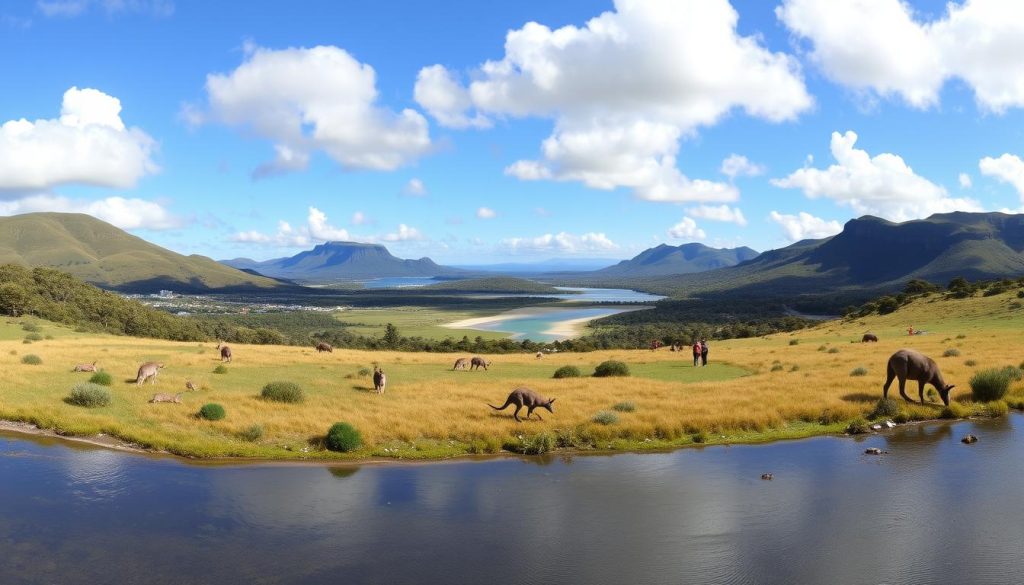
- Wildlife Viewing: See amazing wildlife at dusk. Look out for:
- Grey kangaroos
- Bennett’s wallabies
- Wombats
- Tasmanian devils
- Quolls
- Hiking Adventures: Discover stunning trails and views
- Coastal Exploration: Try water sports on beautiful beaches
- Bird Watching: Watch migratory birds in the Rubicon Estuary
“Narawntapu National Park offers a wilderness experience that connects you directly with Tasmania’s incredible natural world.” – Local Park Ranger
Visit in summer for the best weather, with temperatures from 9°C to 17°C. It’s close to big cities, 42 kilometers from Devonport and a scenic drive from Launceston.
| Activity | Duration | Difficulty |
|---|---|---|
| Coastal Traverse Trail | 9 hours | Challenging |
| Wildlife Viewing | 1-2 hours | Easy |
| Horse Riding | Varies (26km trail) | Moderate |
Whether you love nature, wildlife, or adventure, Narawntapu National Park has something special for you.
Beach Activities and Water Sports
Narawntapu National Park is a haven for those who love the coast. It offers exciting walks and water sports. The park’s beaches and marine life are perfect for water lovers to explore.
Swimming Destinations
Coastal walks in the park lead to amazing swimming spots. Bakers Beach and Badger Beach have clear waters and beautiful views. These beaches are great for:
- Crystal-clear waters ideal for swimming
- Gentle wave conditions for relaxed water activities
- Stunning coastal landscapes for memorable beach days
Boating and Fishing Opportunities
Narawntapu National Park is a dream for anglers and boaters. The boat ramp at Bakers Point makes it easy to explore the coast. Fishing here offers:
- Abundant marine life for recreational fishing
- Access to diverse fishing locations
- Opportunities to catch local fish species
Safety Considerations
When enjoying the coast, safety comes first. Be mindful of:
- Changing tide conditions
- Rocky coastline terrain
- Potential marine hazards
“Respect the ocean, and it will provide unforgettable experiences.” – Local Park Ranger
Always check the weather and bring safety gear. This way, you can fully enjoy Narawntapu’s stunning coast.
Horse Riding Experience
Explore the Tasmanian nature reserve on horseback for an amazing adventure. Narawntapu National Park has a 26-kilometer trail. It takes you through stunning landscapes and diverse ecosystems.
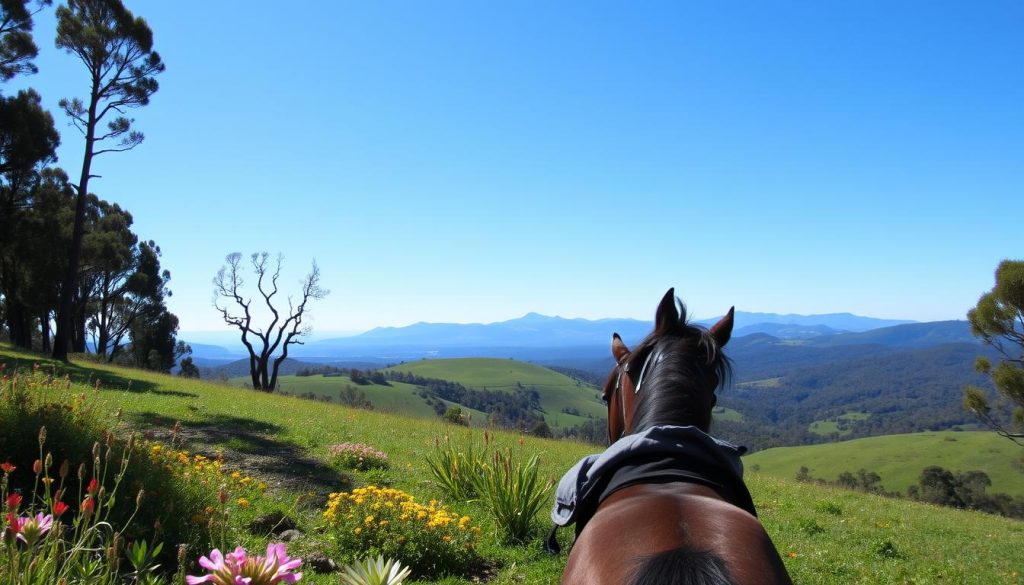
Before you start, remember a few things. You need a permit, and you must book it at least 48 hours early. This makes sure your ride is smooth and well-organized.
Trail Highlights
- Expansive 26-kilometer trail
- Breathtaking coastal and grassland views
- Opportunities for wildlife spotting
- Suitable for various skill levels
Pricing and Booking
| Itinerary Length | Price Range (AUD) |
|---|---|
| 2 Night Ride | $2,775 – $3,150 |
| 3 Night Ride | $3,700 – $4,225 |
| 4 Night Ride | $4,625 – $5,350 |
Pro tip: Solo riders can expect to pay about $5,000 for a 4-night ride. You can book your own room for more flexibility.
“Riding through Narawntapu is like stepping into a living postcard of Tasmania’s wild beauty.” – Local Guide
The park’s Horse Yards are great for overnight stays. They offer a convenient spot for multi-day rides. Whether you’re experienced or new to riding, there’s a trail for you.
Preparation Tips
- Book permits 48 hours in advance
- Check your fitness level
- Bring appropriate riding gear
- Pack water and snacks
Booking with a credit card has a small fee. Domestic cards have a 1.2% surcharge, and international cards have a 2.9% fee. Book early to secure your spot, as some itineraries sell out fast!
Camping and Accommodation Options
Exploring Narawntapu National Park is unforgettable when you camp there. Camping lets you dive deep into Tasmania’s natural beauty.
The park has many camping spots for all kinds of travelers. Whether you’re alone or with family, there’s a place for you.
Springlawn Campground
Springlawn Campground is the main spot for campers. It’s close to the visitor center and has all the basics for a good stay.
- Self-registration system for camping
- Designated fire areas
- Pay showers available
- Electric barbecue facilities
Horse Yards Camping
Horse Yards is perfect for horse lovers. You need a permit and to book at least 48 hours before you arrive.
Additional Camping Locations
There are more places to camp besides Springlawn and Horse Yards:
- Bakers Point
- Koybaa
| Campsite | Features | Amenities |
|---|---|---|
| Springlawn | Central location | Toilets, tables, showers |
| Horse Yards | Equestrian-friendly | Horse facilities, basic amenities |
| Bakers Point | Coastal proximity | Minimal facilities |
| Koybaa | Remote setting | Basic camping provisions |
Pro tip: Always check current park conditions and book in advance during peak seasons to secure your camping spot at Narawntapu National Park.
Bird Watching Paradise
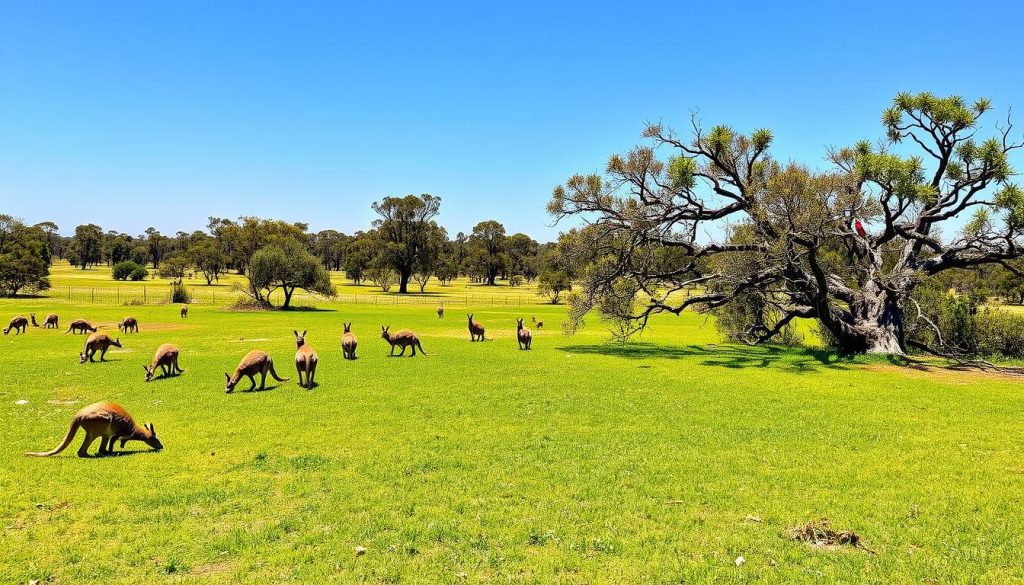
Narawntapu National Park is a top spot for bird watching. It has a wide range of habitats that support many bird species. This makes it a paradise for bird lovers.
Exploring the park, you’ll see some of Tasmania’s most special birds. You’ll also have a chance to see endangered species. This makes bird watching here both thrilling and important.
- Hooded Plover: A rare coastal bird species
- Tasmanian Wedge-tailed Eagle: An impressive predatory bird
- Swift Parrot: A critically endangered species
The northeastern part of the park is especially great for bird watching. It’s part of the Rubicon Estuary Important Bird Area. Both experienced and new bird watchers will find it amazing.
“Tasmania’s unique wildlife transforms bird watching from a hobby into an extraordinary experience.” – Local Wildlife Expert
To get the most out of your bird watching, bring binoculars and a field guide. The best times are early morning and late afternoon. Always keep a safe distance and be quiet to not scare the birds away.
By visiting, you help protect these amazing birds for the future. Your support is crucial for their conservation.
Climate and Best Time to Visit
Planning your trip to Narawntapu National Park means knowing its climate. The park’s weather can change fast, so being ready is key for a great visit.
Each season in Narawntapu National Park brings something special. Summer is warm, with temperatures around 17°C, perfect for outdoor fun. Winter is cooler, near 9°C, offering a different view for nature lovers.
- Summer (December-February):
Warmest months with optimal wildlife viewing opportunities - Autumn (March-May):
Mild temperatures and beautiful landscape colors - Winter (June-August):
Cooler periods with potential for dramatic coastal views - Spring (September-November):
Blooming vegetation and increased animal activity
Wind is a big factor in Narawntapu National Park. Wear layers and clothes that can stand up to the wind. The weather can change quickly, so check the forecast before you go.
“Tasmania’s wilderness demands respect and preparation” – Local Park Ranger
Wildlife fans will love each season. Summer has more daylight for spotting animals. Winter is quieter, with fewer people, for a more peaceful visit.
Conclusion
Narawntapu National Park is a true gem in Tasmania, showcasing the region’s wild beauty. Your visit here is a chance to see wildlife, diverse ecosystems, and stunning views. It’s no wonder it’s called the ‘Serengeti of Tasmania’.
The park has something for everyone. Whether you love wildlife, hiking, or just want peace, Narawntapu has it all. You’ll see kangaroos, enjoy coastal trails, and spot many birds. It’s a top spot in Tasmania.
When you visit, remember to be kind to the environment. Follow the park’s rules and leave nothing behind. Narawntapu is more than a place to visit; it’s a living part of Tasmania’s natural heritage.
Your adventure in Narawntapu National Park is waiting. Bring your curiosity and sense of wonder. Get ready for unforgettable moments in Tasmania’s wilderness. Narawntapu promises memories that will stay with you forever.
The above is subject to change.
Check back often to TRAVEL.COM for the latest travel tips and deals.
